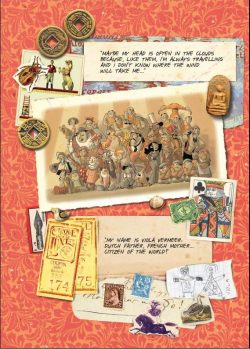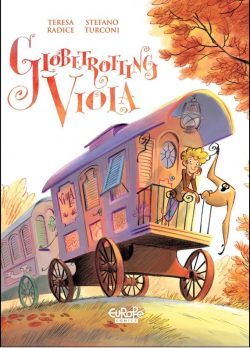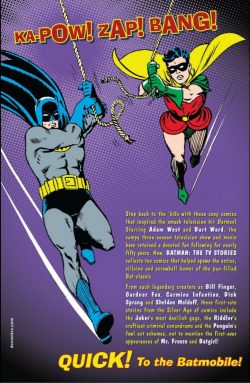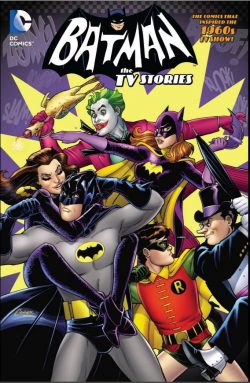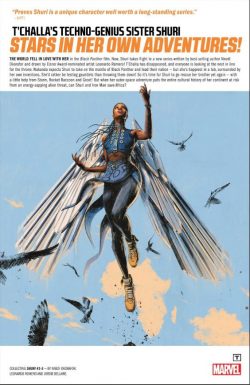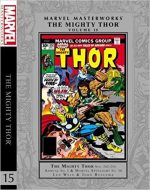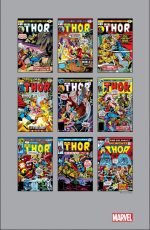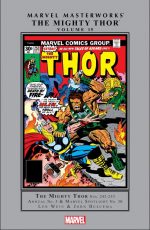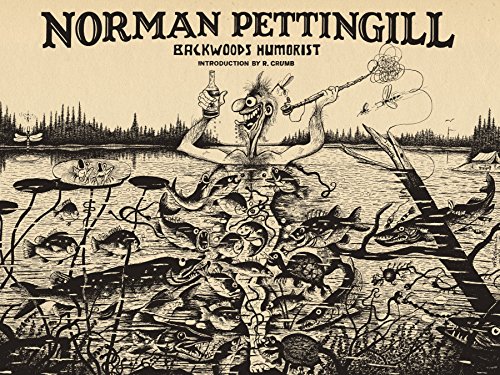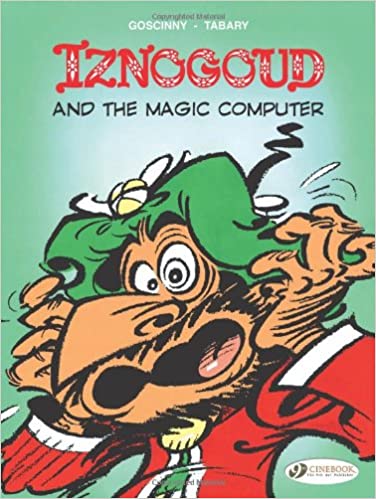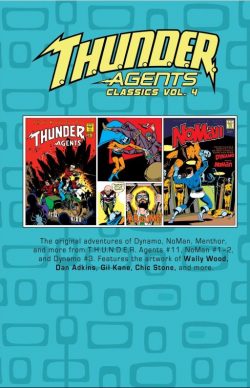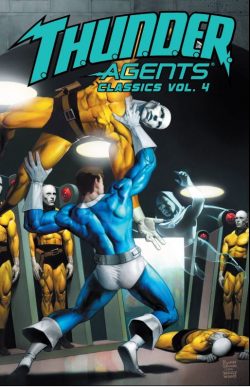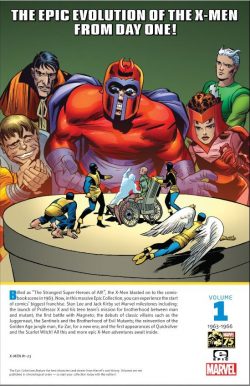
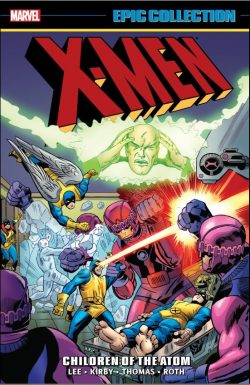
By Stan Lee & Jack Kirby, Roy Thomas, Werner Roth, Alex Toth & various (Marvel)
ISBN: 978-0-7851-8904-6 (TPB)
In 1963 things really took off for the budding Marvel Comics as Stan Lee & Jack Kirby expanded their diminutive line of action titles, putting a bunch of relatively new super-heroes (including hot-off-the-presses Iron Man) together as the Avengers; launching a decidedly different war comic in Sgt. Fury and his Howling Commandos and creating a group of alienated heroic teenagers who gathered together to fight a rather specific, previously unperceived threat to humanity.
Those halcyon days are revisited in this splendid trade paperback and eBook compilation: gathering from September 1963 to August 1966, the contents of X-Men#1-23.
Issue #1 introduced Cyclops, Iceman, Angel and the Beast: very special students of Professor Charles Xavier, a wheelchair-bound telepath dedicated to brokering peace and integration between the masses of humanity and the emergent off-shoot race of mutants dubbed Homo Superior. The story opens as the students welcome their newest classmate, Jean Grey, aka Marvel Girl, a beautiful young woman with the ability to move objects with her mind.
No sooner has the Professor explained their mission than an actual Evil Mutant, Magneto, single-handedly takes over American missile base Cape Citadel. A seemingly unbeatable threat, the master of magnetism is nonetheless driven off – in under 15 minutes – by the young heroes on their first mission …
It doesn’t sound like much, but the gritty dynamic power of Kirby’s art, solidly inked by veteran Paul Reinman, imparted a raw energy to the tale which carried the bi-monthly book irresistibly forward. With issue #2, a Federal connection was established in the form of FBI Special Agent Fred Duncan, who requested the teen team’s assistance in capturing a mutant who threatened to steal US military secrets in ‘No One Can Stop the Vanisher!’.
These days, young heroes are ten-a-penny, but it should be noted that these kids were Marvel’s first juvenile super-doers since the end of the Golden Age, so it’s perhaps unsurprising that in this tale of a terrifying teleporter the outmatched youngsters needed a little adult supervision…
Issue #3’s ‘Beware of the Blob!’ displays a rare lapse of judgement as proselytising Professor X invites a sideshow freak into the team only to be rebuffed by the felonious mutant. Impervious to mortal harm, The Blob incites his carnival cronies to attack the hidden heroes before they can come after him, and once again it’s up to teacher to save the day…
With X-Men #4 (March 1964) a thematic sea-change occurs as Magneto returns at the head of ‘The Brotherhood of Evil Mutants!’ Intent on conquering a South American country and establishing a political powerbase, he ruthlessly dominates Mastermind, Toad, Quicksilver and the Scarlet Witch, who are very much his unwilling thralls in the bombastic struggle that follows. From then on, the callow champions-in-training are the hunted prey of many malevolent mutants.
‘Trapped: One X-Man!’ in issue #5 sees early results in that secret war as Angel is abducted to Magneto’s orbiting satellite base Asteroid M, and only a desperate battle at the edge of space eventually saves him…
‘Sub-Mariner Joins the Evil Mutants!’ is a self-explanatory tale of gripping intensity elevated to magical levels of artistic quality as superb Chic Stone replaced Reinman as inker for the rest of Kirby’s tenure. The issue also incorporates a stunning ‘Special Pin-up page’ starring “Cyclopsâ€.
Genuine narrative progress is made in ‘The Return of the Blob!’ as their mentor leaves on a secret mission, but not before appointing Cyclops acting team leader. Comedy relief is provided as Lee & Kirby introduce Beast and Iceman to the Beatnik-inspired “youth scene†whilst the high action quotient is maintained courtesy of a troubled teaming of the Blob and Magneto’s malign brood…
Another and very different invulnerable mutant debuted in ‘Unus the Untouchable!’: a wrestler with an invisible force field who attempts to enlist in the Brotherhood by offering to bring them an X-Man. Also notable is the first real incident of “anti-mutant hysteria†after a mob attacks Beast: a theme that would become the cornerstone of the X-Men mythos and the delights include a ‘Special Pin-up page’ featuring ‘The Beast’.
X-Men #9 (January 1965) is the first true masterpiece of this celebrated title. ‘Enter, the Avengers!’ reunites the mutants with Professor X in the wilds of Balkan Europe, as deadly Lucifer seeks to destroy Earth with a super-bomb, subsequently manipulating the teens into an all-out battle with the awesome Avengers. This month’s extra treat is a ‘Marvel Masterwork Pin-up’ of ‘Marvel Girl’
This is still a perfect Marvel comic story today, as is its follow-up ‘The Coming of Ka-Zar!’: a wild excursion to Antarctica, featuring the discovery of the Antediluvian Savage Land and the modern incarnation of one of Marvel/Timely’s oldest heroes (Kazar the Great was a pulp Tarzan knock-off who translated to the comics page, originating in October/November 1939’s Marvel Comics #1).
Dinosaurs, lost cities, spectacular locations, mystery and all-out action: it doesn’t get better than this…
After spectacular starts on most of Marvel’s Superhero titles (as well as western and war revamps), Kirby’s increasing workload compelled him to cut back to simply laying out most of these lesser lights whilst Thor and Fantastic Four evolved into perfect playgrounds and full-time monthly preoccupations for his burgeoning imagination. The last series he surrendered was the still-bimonthly X-Men wherein an outcast tribe of mutants worked diligently and clandestinely to foster peace and integration between the unwary masses of humanity and the gradually-emergent “coming race†of Homo Superior.
The King’s departure in #11 was marked by a major turning point. ‘The Triumph of Magneto!’ sees our heroes and the Brotherhood of Evil Mutants both seeking a fantastically powered being dubbed The Stranger. None are aware of his true identity, nature or purpose, but when the Master of Magnetism finds him first, it spells the end of his war with the X-Men…
With Magneto gone and the Brotherhood broken, Kirby relinquished pencilling to other hands, providing loose layouts and design only. Alex Toth & Vince Colletta proved an uncomfortable mix for #12′s tense drama ‘The Origin of Professor X!’ it opened a 2-part saga introducing Xavier’s half-brother Cain Marko and revealed that simplistic thug’s mystic transformation into an unstoppable human engine of destruction.
The story concludes with ‘Where Walks the Juggernaut’: a compelling, tension-drenched tale guest-starring the Human Torch, and most notable for the introduction of penciller Werner Roth (using the name Jay Gavin). He would be associated with the mutants for the next half decade. His inker for this first outing was the infallible Joe Sinnott.
Roth was an unsung veteran of the industry, working for the company in the 1950s on such star features as Apache Kid and the inexplicably durable Kid Colt, Outlaw, as well as Mandrake the Magician for King Features Comics and Man from U.N.C.L.E. for Gold Key. As with many pseudonymous creators of the period, it was his DC commitments (mostly romance stories) which forced him to disguise his moonlighting until Marvel grew big enough to offer him full-time work.
From issue #14 and inked by Colletta, ‘Among us Stalk the Sentinels!’ celebrated the team’s inevitable elevation to monthly publication with the first episode of a 3-chapter epic introducing anthropologist Bolivar Trask, whose solution to the threat of Mutant Domination was super-robots that would protect humanity at all costs. Sadly, their definition of “protect†varied wildly from their creator’s, but what can you expect when a social scientist dabbles in high-energy physics and engineering?
The X-Men took the battle to the Sentinels’ secret base but became ‘Prisoners of the Mysterious Master Mold!’ before wrapping up their ferrous foes with ‘The Supreme Sacrifice!’
Veteran Dick Ayers joined as inker from #15: his clean line blending perfectly with Roth’s clean, classicist pencils. They remained a team for years, adding vital continuity to this quirky but never top-selling series.
X-Men #17 dealt with the aftermath of the battle – the last time the US Army and government openly approved of the team’s efforts – and the sedate but brooding nature of ‘…And None Shall Survive!’ enabled the story to generate a genuine air of apprehension as Xavier Mansion is taken over by an old foe who picks them off one by one until only the youngest remains to battle alone in climactic conclusion ‘If Iceman Should Fail..!’
‘Lo! Now Shall Appear… The Mimic!’ in #19 was Lee’s last script: the pithy tale of a troubled teen possessing the ability to copy the skills, powers and abilities of anyone in close proximity. The writing reins were turned over to Roy Thomas in #20, who promptly jumped in guns blazing with ‘I, Lucifer…’: an alien invasion yarn starring Xavier’s arch-nemesis as well as Unus the Untouchable and the Blob. Most importantly, it revealed in passing how Professor X lost the use of his legs.
With canny concluding chapter ‘From Whence Comes Dominus?’, Thomas & Roth completely made the series their own, blending juvenile high spirits, classy superhero action and torrid soap opera with beautiful drawing and stirring adventure.
At this time Marvel Comics had a vast and growing following among older teens and college kids, and the youthful Thomas spoke and wrote as they did. Coupled with his easy delight in large casts, this would increasingly make X-Men a most welcoming read for any educated adolescent …like you or me…
As suggested already, X-Men was never one of young Marvel’s top titles but it found a devout and dedicated following, with the frantic, freakish energy of Kirby’s heroic dynamism comfortably transiting into the slick, sleek attractiveness of Roth as the fierce tension of hunted, haunted juvenile outsider settled into a pastiche of college and school scenarios so familiar to the students who were the series’ main audience.
The action pauses here with a crafty 2-parter resurrecting veteran Avengers villain Count Nefaria who employs illusion-casting technology and a band of other heroes’ second-string foes (Unicorn, Porcupine, Plantman, Scarecrow and the Eel, if you’re wondering) to hold Washington DC hostage and frame the X-Men for the entire scheme.
‘Divided… We Fall!’ and ‘To Save a City!’ comprise a fast-paced, old-fashioned Goodies vs. Baddies battle with a decided sting in the tail. Moreover, the tale concludes with Marvel Girl yanked off the team as her parents insist she furthers her education by leaving the Xavier School to attend New York’s Metro University…
To Be Continued…
Supplemented by a copious gallery of original art pages – by Kirby, Reinman, Roth & Ayers – a wealth of evocative house ads and an unseen never used alternate cover by Kirby & Stone, these quirky tales are a million miles removed from the angst-ridden, breast-beating, cripplingly convoluted X-brand of today’s Marvel and, in many ways are all the better for it. Superbly rendered, highly readable adventures are never unwelcome or out of favour, and it should be remembered that everything here informs so very much of the mutant monolith. These are stories for dedicated fans and rawest converts. Everyone should have this book.
© 2019 MARVEL.


